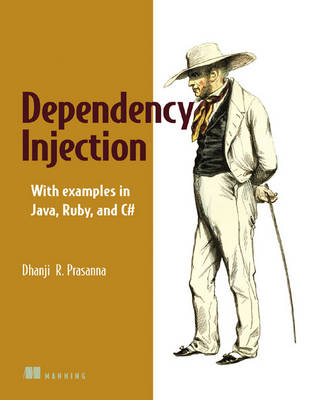
Dependency Injection
with examples in Java, Ruby, and C#
Seiten
2009
Manning Publications (Verlag)
978-1-933988-55-9 (ISBN)
Manning Publications (Verlag)
978-1-933988-55-9 (ISBN)
- Titel ist leider vergriffen;
keine Neuauflage - Artikel merken
HIGHLIGHT
The “Dependency Injection” (DI) pattern is the primary idea behind the enormously
popular Spring Framework and Google Guice. This book shows Java
developers how to effectively use DI in multiple frameworks and contexts and
presents the most current technologies, techniques and best practices.
DESCRIPTION
Dependency Injection is an in-depth guide to the current best practices for
using the Dependency Injection pattern—the key concept in Spring and the
rapidly-growing Google Guice. It explores Dependency Injection, sometimes
called Inversion of Control, in fine detail with numerous practical examples.
Developers will learn to apply important techniques, focusing on their strengths
and limitations, with a particular emphasis on pitfalls, corner-cases, and best
practices.
This book is written for developers and architects who want to understand
Dependency Injection and successfully leverage popular DI technologies such as
Spring, Google Guice, PicoContainer, and many others. The book explores
many small examples of anchor concepts and unfolds a larger example to show
the big picture.
Written primarily from a Java point-of-view, this book is appropriate for any
developer with a working knowledge of object-oriented programming in Java,
Ruby, or C#.
KEY POINTS
• Both highly technical and highly practical
• Numerous examples in multiple languages, frameworks, and contexts
• The only book available that covers DI from a framework-agnostic perspective;
most concentrate only on Spring.
MARKET INFORMATION
Dependency Injection is one of the most important ideas of the past decade for
object-oriented developers, but it isn’t widely understood at a technical level. DI
has increased in importance as developers have embraced the Agile ideas of
building testable and maintainable code. All Java developers need to master the
DI concepts in this book.
The “Dependency Injection” (DI) pattern is the primary idea behind the enormously
popular Spring Framework and Google Guice. This book shows Java
developers how to effectively use DI in multiple frameworks and contexts and
presents the most current technologies, techniques and best practices.
DESCRIPTION
Dependency Injection is an in-depth guide to the current best practices for
using the Dependency Injection pattern—the key concept in Spring and the
rapidly-growing Google Guice. It explores Dependency Injection, sometimes
called Inversion of Control, in fine detail with numerous practical examples.
Developers will learn to apply important techniques, focusing on their strengths
and limitations, with a particular emphasis on pitfalls, corner-cases, and best
practices.
This book is written for developers and architects who want to understand
Dependency Injection and successfully leverage popular DI technologies such as
Spring, Google Guice, PicoContainer, and many others. The book explores
many small examples of anchor concepts and unfolds a larger example to show
the big picture.
Written primarily from a Java point-of-view, this book is appropriate for any
developer with a working knowledge of object-oriented programming in Java,
Ruby, or C#.
KEY POINTS
• Both highly technical and highly practical
• Numerous examples in multiple languages, frameworks, and contexts
• The only book available that covers DI from a framework-agnostic perspective;
most concentrate only on Spring.
MARKET INFORMATION
Dependency Injection is one of the most important ideas of the past decade for
object-oriented developers, but it isn’t widely understood at a technical level. DI
has increased in importance as developers have embraced the Agile ideas of
building testable and maintainable code. All Java developers need to master the
DI concepts in this book.
Dhanji R. Prasanna is an Enterprise Java consultant for technologies such as EJB3, JBI, JSF, Guice, Spring, HiveMind, and PicoContainer. He is a co-author of the Bean Validation (JSR-303), JAX-RS (JSR-311), Servlet 3.0 (JSR-315), and JavaServerFaces 2.0 (JSR-314) specifications. He is also co-author of the Java EE 6.0 (JSR-316) platform specification, which is the next edition of J2EE.
| Erscheint lt. Verlag | 20.8.2009 |
|---|---|
| Zusatzinfo | Illustrations |
| Verlagsort | New York |
| Sprache | englisch |
| Maße | 189 x 234 mm |
| Gewicht | 570 g |
| Themenwelt | Informatik ► Programmiersprachen / -werkzeuge ► Java |
| ISBN-10 | 1-933988-55-X / 193398855X |
| ISBN-13 | 978-1-933988-55-9 / 9781933988559 |
| Zustand | Neuware |
| Haben Sie eine Frage zum Produkt? |
Mehr entdecken
aus dem Bereich
aus dem Bereich
mit über 150 Workouts in Java und Python
Buch (2023)
Carl Hanser (Verlag)
29,99 €
Einführung, Ausbildung, Praxis
Buch | Hardcover (2023)
Rheinwerk (Verlag)
49,90 €


